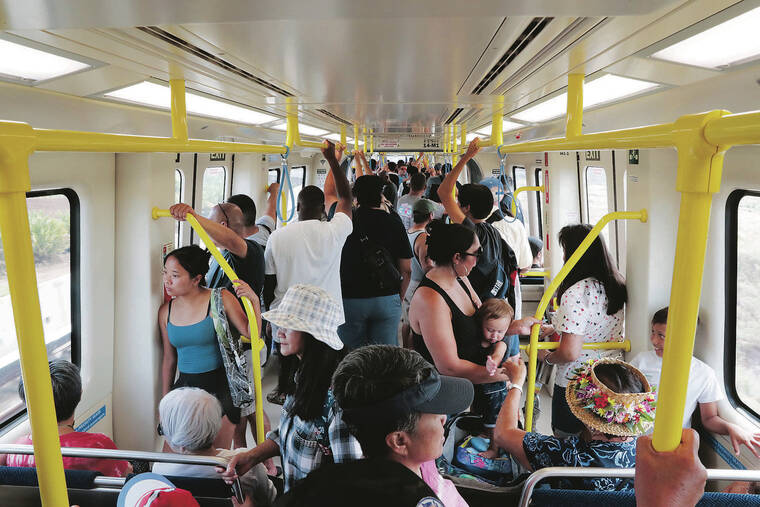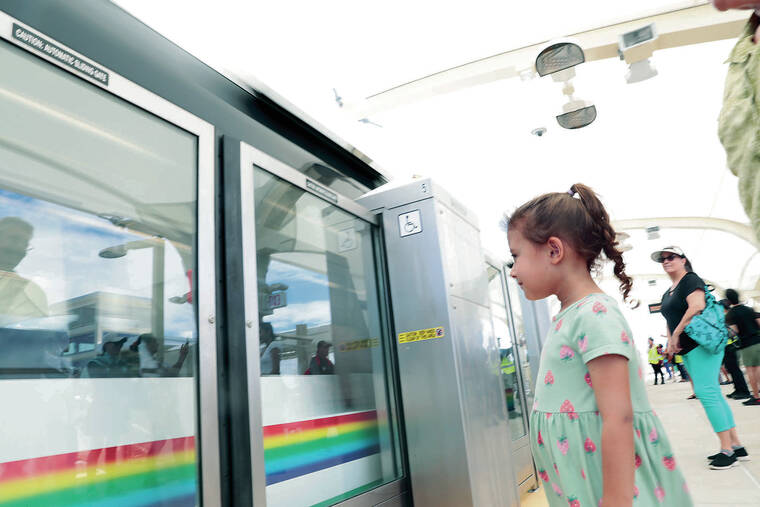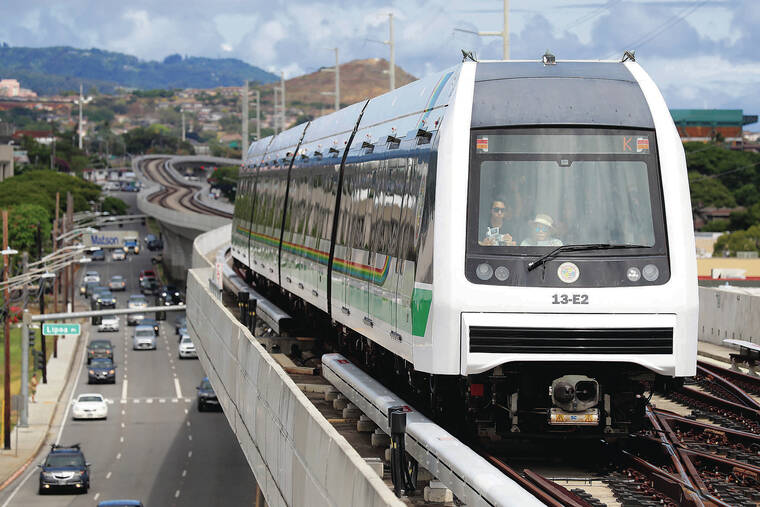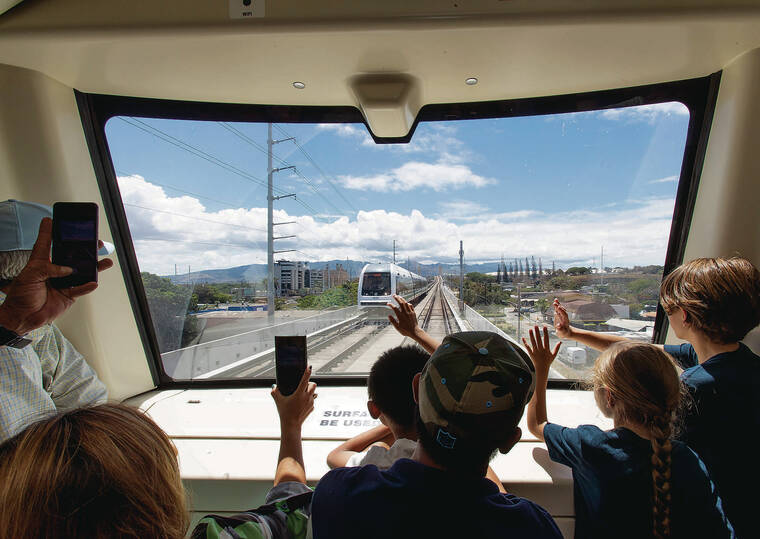Approximately 9,000 passengers took advantage of free rail rides and the novelty of experiencing Honolulu’s new elevated transit system when it opened to the public for the first time Friday.
Even more passengers are expected as free rides continue through the Fourth of July — and with longer hours of service.
But the real test begins Wednesday when passengers will have to pay to ride the Skyline trains using HOLO cards, which will offer the first measurement of actual interest in riding rail from East Kapolei to the Halawa station across from Aloha Stadium.
Even with the first phase of the $9.8 billion rail line officially open, it’s still unclear how many passengers are needed to ride the system, how much revenue they would generate and what the real costs of maintenance will be.
“We want to know if we’re actually breaking even or in the red every year with this small segment of rail,” Honolulu City Council member Andria Tupola said Saturday. “It would be nice to know what the ridership will be that we need.”
Too many variables remain unknown, such as the annual maintenance costs for the trains, 11-mile track, nine stations and the system overall, Tupola said.
“The next year will basically be a pilot project until next July,” she said.
Rail officials have not been able to provide revenue projections for ridership except to say that a portion of passenger fares would go toward operations and maintenance.
Roger Morton, director of the city Department of Transportation Services, which in June assumed responsibility for operating Skyline, earlier said the contract with Hitachi Rail is a $54 million-per-year expense, while operational costs, including use of electricity throughout the system, adds up to $75 million annually.
According to Morton, the city expects about 8,000 to 10,000 riders per day by the end of the year, with the next segment from Halawa past the airport to Middle Street likely generating about 25,000 riders per day. Ridership is expected to grow to about 85,000 per day after the final segment opens from Middle Street to the Downtown and Kakaako area.
DTS only recently decided on a fare plan to merge the cost of riding rail into the price of riding TheBus, partially to encourage rail passengers to rely on TheBus to get to and from Skyline stations.
Further complicating projected rail revenue are discussions about encouraging rail ridership with possible future free days, Tupola said.
Traffic congestion and residential development in her Leeward Council district are the primary reasons behind the push to build rail in the first place to ease residents’ commutes, reduce traffic and encourage use of public transportation.
Tupola has frequently asked tough questions about rail and said she plans to ride it for the first time this weekend with her two children. She remains concerned about how many passengers will actually pay to ride Skyline from her district to Halawa, especially since Aloha Stadium was deemed unsafe for spectator events in 2020.
“There’s not too much action at that end point,” she said.
She also has seen videos taken by the first rail passengers of locked station bathrooms.
But Tupola also has heard “the view is nice and everyone was just excited to get on it. A lot of people thought this day would never come, that we would never get a functioning portion of rail.”
Council member Val Okimoto’s district includes two rail stations: Pearlridge, or Kalauao, and Pearl Highlands, or Waiawa, which lost a planned 1,600-stall parking structure in order to reduce construction costs.
She remains concerned about the safety of pedestrians mixing with busy traffic along Moanalua Road while they enter and exit the rail stations.
Asked about the lack of hard ridership projections and operating and maintenance costs, Okimoto said, “They don’t know yet. I do have concerns but I remain optimistic. I do want to ensure that the costs to operate and maintain rail will be sustainable.”
As ongoing construction extends rail to Kakaako by 2031 while looking for new sources of money to push on to its original terminus at Ala Moana Center, Okimoto said the Honolulu Authority for Rapid Transportation “must continue to be held accountable to ensure that taxpayer money is being used wisely and prudently.”
And after riding Skyline in advance of Friday’s opening, Okimoto also is worried about passenger comfort and safety.
“I thought the ride wasn’t as smooth as I anticipated,” she said Saturday.
Her experience was shared by some passengers during Friday’s inaugural runs. One 83-year-old man fell on his face after his train left the Pouhala station at the Waipahu Transit Center. Passengers rushed to his aid, pulled him up and found him an open seat.
Okimoto said that after her rail experience, “I thought, this is going to be harder for the kupuna. The stops and starts weren’t as smooth.”
She wants to ride Skyline again this weekend with her two daughters and hopes fellow passengers extend aloha, especially to kupuna.
“I definitely hope we live by the aloha spirit,” she said, “and just go back to the way we were raised.”
DTS spokesperson Travis Ota agreed. He acknowledged that Friday’s rides were “a little shaky for some people.”
Ota encouraged younger and able-bodied passengers to let people in wheelchairs and using walkers to board first and give up seats to keiki and kupuna out of courtesy, but especially for their safety.
“To kupuna, please hang on to something,” Ota said. “To other passengers, please offer a seat. Keiki and kupuna are more vulnerable. We want that kind of aloha.”
—
Skyline tips
How to ride
>> Now through the Fourth of July, the public can ride the first phase of the rail line for free with a valid HOLO card. New HOLO cards cost $2 and there is a $3 minimum to load the card. Riders must tap the HOLO card at fare gates to enter the individual stations, but fares will not be deducted from their cards.
>> All stations close at 7 p.m., but in order to ride the full 11-mile, nine-station route from Kualaka‘i station in East Kapolei to the Halawa station near Aloha Stadium, or vice versa, passengers must board by 6 p.m.
>> HOLO cards can be purchased at local retailers, ticket-vending machines at each rail station entrance or TheBus Pass Office. Senior, disability and youth riders can apply for a reduced-fare HOLO card at TheBus Pass Office at the Kalihi Transit Center. Visit thebus.org Opens in a new tab for HOLO card application requirements. For more information about HOLO cards and a list of retailers that sell them, visit holocard.net Opens in a new tab or call 808-768-4656.
>> TheBus will be providing free rides to all riders through the Fourth of July, with new bus routes and schedules in effect. For more information on “bus-rail integration,” visit honolulu.gov/skyline. For TheBus schedules and routes, visit thebus.org.
Parking
>> Only three of the nine rail stations have parking. The Halawa station at Aloha Stadium has 580 spaces, the Keone‘ae station at the University of Hawaii West Oahu has 304 spaces and the Honouliuli station at Ho‘opili has 344 spaces. Parking is free and the parking lots will close when the stations close.
Hours of operation
>> Weekday hours are 5 a.m. to 7 p.m.; weekend and holiday hours are 8 a.m. to 7 p.m.
Fares
>> After Tuesday, fares for rail will follow the same fare structure as TheBus. One tap of the HOLO card will allow riders to enter the station and board the next available train. Once the rider taps their card, they will be given a transfer, which allows them to board another train or TheBus without being charged for a 2-1/2-hour period.
>> Single fares after the free tryout period will be $3 for adults, $1.50 for youth (ages 6-17) and $1.25 for seniors (ages 65 and older).
More information
>> Visit honolulu.gov/skyline Opens in a new tab or thebus.org Opens in a new tab.
Source: Honolulu Department of Transportation Services








